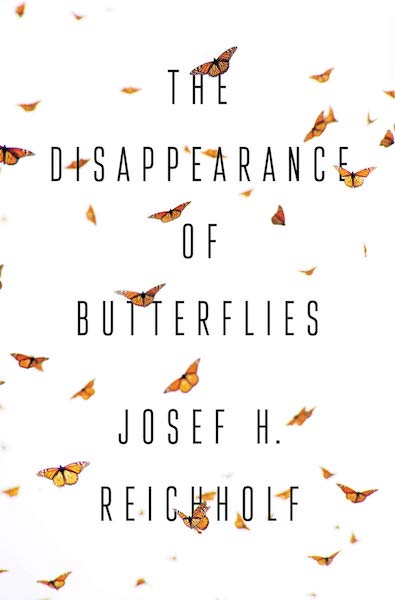 |
by Josef H. Reichholf (Author), Gwen Clayton (Translator)
In the last fifty years our butterfly populations have declined by more than eighty per cent and butterflies are now facing the very real prospect of extinction. It is hard to remember the time when fields and meadows were full of these beautiful, delicate creatures – today we rarely catch a glimpse of the Wild Cherry Sphinx moths, Duke of Burgundy or the even once common Small Tortoiseshell butterflies. The High Brown Fritillary butterfly and the Stout Dart Moth have virtually disappeared.
The eminent entomologist and award-winning author Josef H. Reichholf began studying butterflies in the late 1950s. He brings a lifetime of scientific experience and expertise to bear on one of the great environmental catastrophes of our time. He takes us on a journey into the wonderful world of butterflies - from the small nymphs that emerge from lakes in air bubbles to the trusting purple emperors drunk on toad poison - and immerses us in a world that we are in danger of losing forever. Step by step he explains the science behind this impending ecological disaster, and shows how it is linked to pesticides, over-fertilization and the intensive farming practices of the agribusiness.
His book is a passionate plea for biodiversity and the protection of butterflies.
Josef Reichholf is an environmental biologist and author who has twice received the German Science Book of the Year prize.
I've been dipping in and out of this book for a few weeks now and, I have to say, it is always a delight to come back to - the sign of a good read! And so my compliments to Gwen Clayton, who has done an incredible job of translating the work of Dr. Josef Reichholf from its original German, with almost all of the experiences shared in the book coming from the author's home country. If there is one message that the book conveys loud and clear, it is that the fauna in many parts of the world is suffering the same fate, and for the same reasons, that are nicely spelled out here.
But first things first - and at the top of my list is that the book's title is somewhat misleading, for the book is neither just about butterflies (moths get equal coverage), nor just about their disappearance (Lepidoptera biodiversity is also a significant element). To put this comment and others in context, I felt that sharing the contents listing would be useful to readers and prospective buyers:
Part I: The Biodiversity of LepidopteraPart 1, I feel, is a refreshing reminder of the incredible diversity of our Lepidoptera fauna and, most importantly, a reminder of why we should care about this unique group of creatures, should any of us need reminding! But, more than that, part 1 is chock-a-block full of insights that even the most committed Lepidopterist will undoubtedly learn from. As the author writes: "I shall begin this book with descriptions of the natural beauty and abundance that I once experienced myself, in part to explain why the disappearance of the butterflies affects me so deeply". He goes on: "My records prevent me from creating rose-tinted memories of past conditions ... I started keeping records on nature on 15 December 1958".
We are then led through a series of chapters on fascinating topics, each of which is full of anecdotes, useful information and opinions. I'll admit that I was unaware of aquatic moths whose larvae live under water. Even with more familiar subjects, such as the Purple Emperor, I enjoyed reading the tale of Purple Emperors that were feeding on the toxins from a poisonous toad with interesting consequences. Although not a native of Britain, I really enjoyed reading the insights into the Map butterfly when discussing nettle-feeding Lepidoptera, given that this is one of those species that may, one day, make it to our shores. I'd never really thought of the Small Tortoiseshell as a migrant, but reading about this butterfly from a continental European perspective was both refreshing and informative. I could go on.
To summarise, if part 1 is setting us up for part 2, then it does the job - our Lepidoptera fauna is fascinating, beautiful and unique - something to be treasured and protected.
As one might expect, part 2 focuses on the symptoms that we experience with a decreasing Lepidoptera fauna, providing a thorough analysis of the root causes, where the author pulls no punches. This part starts with some shocking statistics, but always approached from the author's personal observations which makes them even harder hitting - the author refers to his own village when discussing butterfly species that live in meadows, where there has been a 73% decline between 1976 and 2016.
The author refreshingly answers some fundamental questions - why are warm summers bad news for butterflies, and fertilizers? What about the general state of the countryside - and more urban areas where light pollution is a menace? Rest assured that no stone is left unturned with some bold suggestions as to what the future might hold - could cities become refuges? This book certainly made me think and turned some assumptions I had on their head: "It is by no means just in the city that there is an influx of nutrients and pollutants through the air; the fields and the forests also receive a large quantity ... when it comes to quantity ... the volume recorded for municipal areas is essentially far lower than that for the fields".
We are at such a pivotal moment when it comes to protecting all species and our environment that we sometimes need to be reminded of what we have to lose. But if we are to effect change, then we must first understand what the problems are, and their potential solutions, and this is where this book excels. I hope this book gets the readership it deserves - highly recommended.